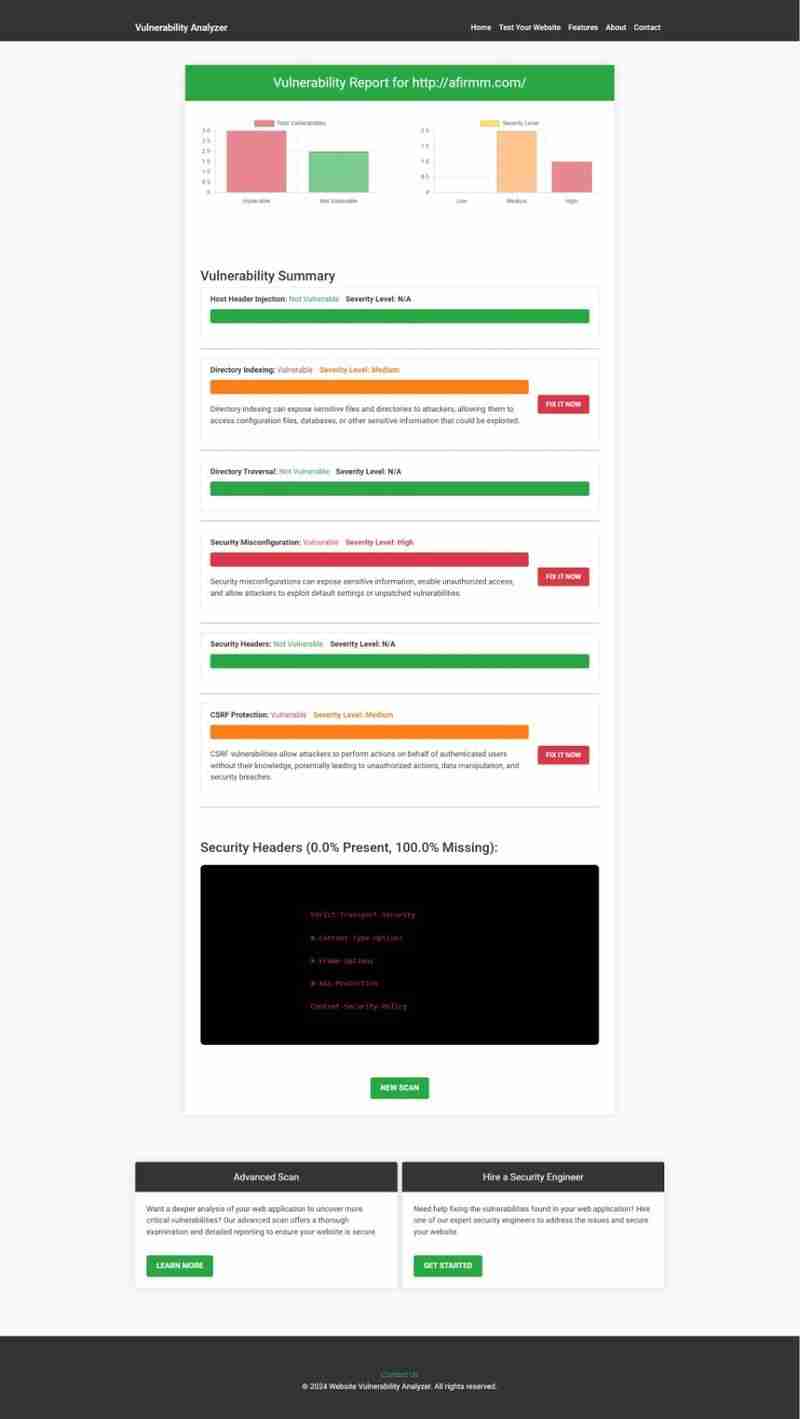 Backend Development
Backend Development
 PHP Tutorial
PHP Tutorial
 Path Manipulation in Laravel: Secure Your App from Vulnerabilities
Path Manipulation in Laravel: Secure Your App from Vulnerabilities
Path Manipulation in Laravel: Secure Your App from Vulnerabilities
Introduction
Laravel is a popular PHP framework, valued for its clean architecture and developer-friendly environment. However, improper handling of file paths can expose your application to Path Manipulation Vulnerabilities. These vulnerabilities occur when attackers manipulate file paths to access restricted files or directories.

In this blog, we’ll explore what path manipulation is, its risks, and how you can prevent it in Laravel with hands-on coding examples. Additionally, we'll show you how our free Website Security Scanner tool can detect such vulnerabilities in your application.
What is Path Manipulation?
Path manipulation happens when user-controlled input allows access to files outside the intended directory. This can lead to:
- Unauthorized Data Access: Attackers might access sensitive files like configuration or logs.
- File Modification: Attackers could alter critical files.
- Execution of Malicious Scripts: Executing scripts stored in unintended locations.
How Does Path Manipulation Work?
Attackers craft input that exploits the file system’s directory traversal mechanism. For instance:
$file = $_GET['file'];
include("/var/www/html/uploads/" . $file);
If the user sends file=../../etc/passwd, the script could read sensitive server files:
include("/var/www/html/uploads/../../etc/passwd");
Preventing Path Manipulation in Laravel
Laravel provides built-in methods to mitigate such risks. Let’s dive into practical solutions:
1. Validate and Sanitize Inputs
Always validate user inputs to ensure they don’t contain malicious paths.
$request->validate([
'file' => 'required|string|alpha_dash'
]);
2. Use Laravel’s Storage Class
Leverage Laravel’s Storage facade to manage file paths securely:
use Illuminate\Support\Facades\Storage;
$file = $request->input('file');
// Securely fetch the file path
$path = Storage::path('uploads/' . basename($file));
if (Storage::exists($path)) {
return response()->download($path);
}
Coding Example: Secure File Retrieval
Here’s a complete example of securely retrieving files:
$file = $_GET['file'];
include("/var/www/html/uploads/" . $file);
Why This Code is Secure
- basename() prevents directory traversal.
- storage_path() confines file paths to Laravel’s storage directory.
- Ensures the file exists before serving.
How Our Free Tool Detects Path Manipulation
 Screenshot of the free tools webpage where you can access security assessment tools.
Screenshot of the free tools webpage where you can access security assessment tools.
Using our free Website Security Checker, tool you can scan your web application for path manipulation vulnerabilities. The tool generates a detailed vulnerability assessment report, helping you secure your application.
Real-Time Example with Our Tool
Below is a screenshot of a Vulnerability Assessment Report generated by our tool:
 An example of a vulnerability assessment report generated with our free tool provides insights into possible vulnerabilities.
An example of a vulnerability assessment report generated with our free tool provides insights into possible vulnerabilities.
Conclusion
Path manipulation vulnerabilities can compromise your Laravel applications. By validating inputs, using secure methods like Storage, and conducting regular vulnerability assessments with tools like ours to test website security free, you can significantly reduce risks.
Take proactive steps to secure your application today, and don’t forget to test your application regularly with our tool for enhanced protection.
Have you scanned your Laravel application for vulnerabilities? Check it now with our free Website Security Scanner and stay secure!
The above is the detailed content of Path Manipulation in Laravel: Secure Your App from Vulnerabilities. For more information, please follow other related articles on the PHP Chinese website!

Hot AI Tools

Undresser.AI Undress
AI-powered app for creating realistic nude photos

AI Clothes Remover
Online AI tool for removing clothes from photos.

Undress AI Tool
Undress images for free

Clothoff.io
AI clothes remover

Video Face Swap
Swap faces in any video effortlessly with our completely free AI face swap tool!

Hot Article

Hot Tools

Notepad++7.3.1
Easy-to-use and free code editor

SublimeText3 Chinese version
Chinese version, very easy to use

Zend Studio 13.0.1
Powerful PHP integrated development environment

Dreamweaver CS6
Visual web development tools

SublimeText3 Mac version
God-level code editing software (SublimeText3)

Hot Topics
 Alipay PHP SDK transfer error: How to solve the problem of 'Cannot declare class SignData'?
Apr 01, 2025 am 07:21 AM
Alipay PHP SDK transfer error: How to solve the problem of 'Cannot declare class SignData'?
Apr 01, 2025 am 07:21 AM
Alipay PHP...
 Explain JSON Web Tokens (JWT) and their use case in PHP APIs.
Apr 05, 2025 am 12:04 AM
Explain JSON Web Tokens (JWT) and their use case in PHP APIs.
Apr 05, 2025 am 12:04 AM
JWT is an open standard based on JSON, used to securely transmit information between parties, mainly for identity authentication and information exchange. 1. JWT consists of three parts: Header, Payload and Signature. 2. The working principle of JWT includes three steps: generating JWT, verifying JWT and parsing Payload. 3. When using JWT for authentication in PHP, JWT can be generated and verified, and user role and permission information can be included in advanced usage. 4. Common errors include signature verification failure, token expiration, and payload oversized. Debugging skills include using debugging tools and logging. 5. Performance optimization and best practices include using appropriate signature algorithms, setting validity periods reasonably,
 How does session hijacking work and how can you mitigate it in PHP?
Apr 06, 2025 am 12:02 AM
How does session hijacking work and how can you mitigate it in PHP?
Apr 06, 2025 am 12:02 AM
Session hijacking can be achieved through the following steps: 1. Obtain the session ID, 2. Use the session ID, 3. Keep the session active. The methods to prevent session hijacking in PHP include: 1. Use the session_regenerate_id() function to regenerate the session ID, 2. Store session data through the database, 3. Ensure that all session data is transmitted through HTTPS.
 Describe the SOLID principles and how they apply to PHP development.
Apr 03, 2025 am 12:04 AM
Describe the SOLID principles and how they apply to PHP development.
Apr 03, 2025 am 12:04 AM
The application of SOLID principle in PHP development includes: 1. Single responsibility principle (SRP): Each class is responsible for only one function. 2. Open and close principle (OCP): Changes are achieved through extension rather than modification. 3. Lisch's Substitution Principle (LSP): Subclasses can replace base classes without affecting program accuracy. 4. Interface isolation principle (ISP): Use fine-grained interfaces to avoid dependencies and unused methods. 5. Dependency inversion principle (DIP): High and low-level modules rely on abstraction and are implemented through dependency injection.
 How to debug CLI mode in PHPStorm?
Apr 01, 2025 pm 02:57 PM
How to debug CLI mode in PHPStorm?
Apr 01, 2025 pm 02:57 PM
How to debug CLI mode in PHPStorm? When developing with PHPStorm, sometimes we need to debug PHP in command line interface (CLI) mode...
 How to automatically set permissions of unixsocket after system restart?
Mar 31, 2025 pm 11:54 PM
How to automatically set permissions of unixsocket after system restart?
Mar 31, 2025 pm 11:54 PM
How to automatically set the permissions of unixsocket after the system restarts. Every time the system restarts, we need to execute the following command to modify the permissions of unixsocket: sudo...
 Explain late static binding in PHP (static::).
Apr 03, 2025 am 12:04 AM
Explain late static binding in PHP (static::).
Apr 03, 2025 am 12:04 AM
Static binding (static::) implements late static binding (LSB) in PHP, allowing calling classes to be referenced in static contexts rather than defining classes. 1) The parsing process is performed at runtime, 2) Look up the call class in the inheritance relationship, 3) It may bring performance overhead.
 How to send a POST request containing JSON data using PHP's cURL library?
Apr 01, 2025 pm 03:12 PM
How to send a POST request containing JSON data using PHP's cURL library?
Apr 01, 2025 pm 03:12 PM
Sending JSON data using PHP's cURL library In PHP development, it is often necessary to interact with external APIs. One of the common ways is to use cURL library to send POST�...





